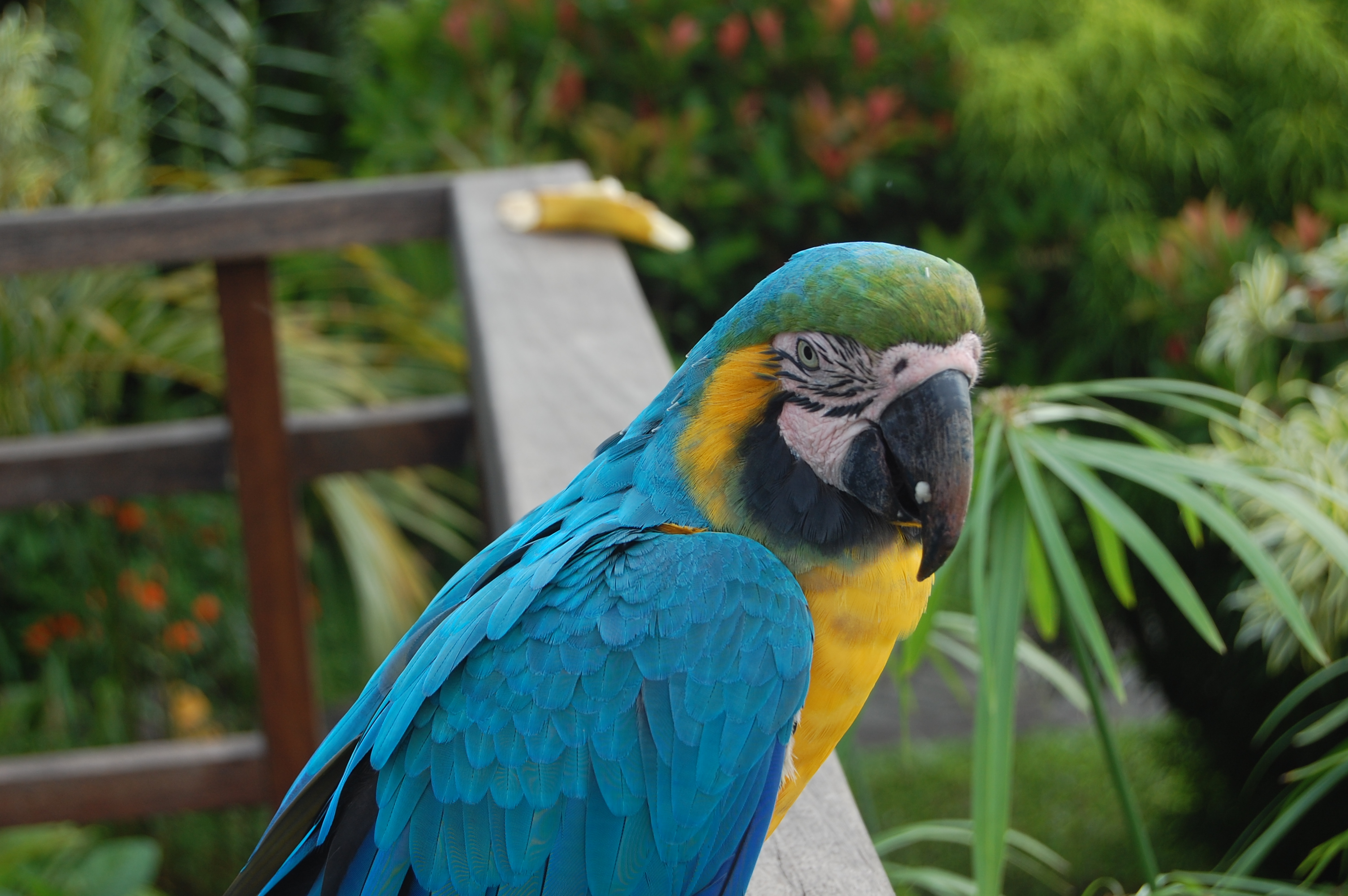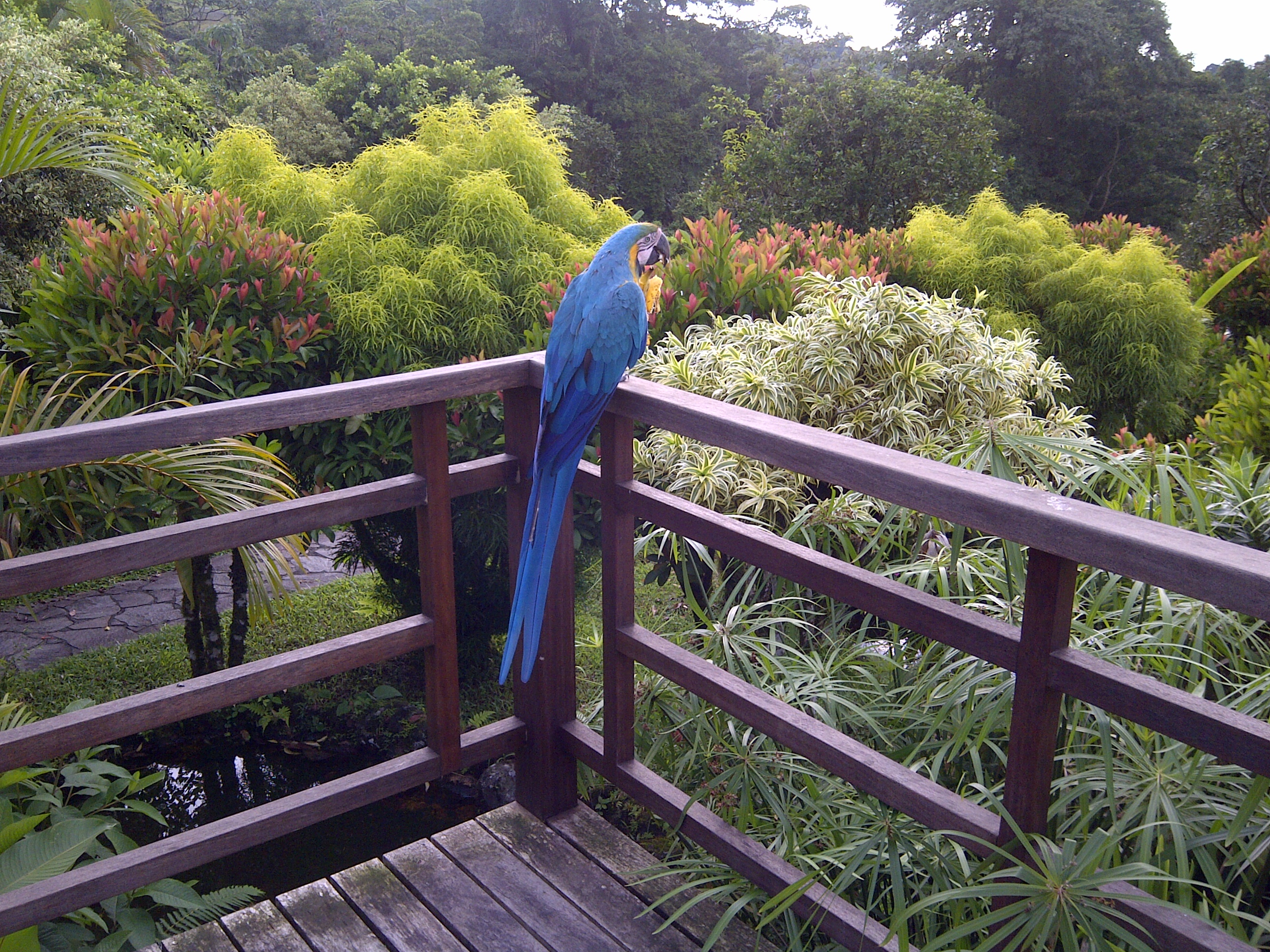Sometimes you travel to a place and something happens that defines the core of your journey. It might be anything – a conversation with a stranger, a view that captures your soul, an animal that shadows you on the way back to your lodging, a particular food you sample, a dream, a vision, people you meet. For me and my introduction to Costa Rica, that special something was Stephanie, the macaw.
I think we first saw her when we were several miles from Arenal Lodge. We had stopped to take photos, each of us heading off in different directions – into trees, to the lip of a cliff – and a light rain was falling. Megan and I ended up in the same spot at some point and we heard the bird’s cries and looked up.
Up high in the trees, sixty or seventy feet up – a bird with a long tail circled through the mist, its cries hauntingly eerie. “It’s a Quetzl bird,” I shrieked.
“What’s that?” Megan asked.
Well, okay, where did that conclusion come from? Something I’d read, no doubt about the rare Quetzl bird sighted in certain parts of Costa Rica.
Megan got out her camera with its zoom lens, but the bird was simply too high to see clearly. When Rob joined us, he took a look and shook his head. “I can’t see it well enough to tell what it is,” he said.
We drove on through the mist, reached the lodge, checked in. That evening before dinner, we stopped by the bar for a drink. It was dusk, the bar was as open as the rest of the lodge, the cool mountain air flowing in. And then we saw it, the Quetzl, shrieking, crying out, making a wide sweep again the hallucinogenic sky. The bird finally settled at the edge of the bar and the bartender quickly cut up some fruit, put it on a plate, and set it on the window for the most beautiful blue and green macaw I’ve ever seen – and I’d never seen one outside of a zoo.
“Who’s that?” I asked.
“Stephanie,” he replied.
Uh-oh. He had named the bird. When you name a creature in the wild, it means there’s some anthropomorphic stuff going on. You know, the same sort of exchange that occurs daily with the animal companions who share your life. Except that Stephanie was wild. The bartender, who fed her daily, couldn’t touch her. No one could touch her. But she knew where to come for her fruit plate, her sugar water, to pose for photos. Then I remembered that the only macaw native to Costa Rica are the red variety, not the blue.
“She’s not doing too well,” the bartender said. “Her mate was killed a few weeks ago. They mate for life, you know.”
For the next three days, every staff member we talked to about Stephanie repeated the same story. Apparently Stephanie and her partner were brought to Costa Rica from Brazil, by the woman who owns the lodge. The owner is Canadian, was married to a Brazilian, and when he died, she inherited the lodge and its 2,000 acres. From what we understand, Stephanie and her partner arrived about six years ago and were set free on the property.
The male was apparently the friendlier of the two, the more trusting, the one who allowed humans to stroke his feathers and who would eat from your hand if you offered something delectable. One day, he was in or near the closest town of La Fortuna and pecking at some shiny stuff on a car. The owner freaked and hurled something at the male. In Spanish, the word for this is golpear – a violent blow– and that blow killed him.
I was so horrified by this story that I plied the bartender with questions. Was this person male or female? A tourist or a local? How did the lodge find out about it? The person who did it was apparently a male tourist. The macaws were well known in the area and a local brought the bird’s body to the lodge and explained what had happened.
“She mourns,” one waiter told us.
“She isn’t like she used to be,” another employee confided.
Megan, of course, kept trying to get Stephanie to take a piece of fruit from her hand, but Stephanie wasn’t having any of it. Megan did get close enough to run her fingers across Stephanie’s tail feathers.
Every evening after Stephanie had sampled the delicious fruits and sipped from her glass of sugar water, she would flutter over to the railing and gaze out at the volcano, at the utter lushness of this place. She was listening, watching, alert. You could see something in the way she held herself, body tense, vigilant. I always had the feeling she was waiting for her mate to return.
Rob asked what the synchro is and I can’t find one. But there’s a deeper meaning here. Really, look at that photo, the bird alone on the railing, the only one of her kind in the entire country (so the employees said), facing the dusk and the impending darkness by herself. Stephanie’s story resonates with the more profound elements in human life, that of loss and redemption, and a hope that perseveres.











Wow. A picture of the two mated birds would have been beautiful. This story and the picture are even more powerful for the beauty and the message. I hope Stephanie lives a long time for her kind.
No one seemed to have any pictures of the two of them together.
BTW – My sister’s name is Stephanie.
Synchro! Did you see Nat’s comment?
Back again ~ I switched on my laptop this morning and noticed I had a new Fb friend named Stephanie. I came here to read your post and it was about Stephanie the macaw.
Proceeded to have a shower and little Haylie came in with a toy she dug up from under bed….a macaw! Three in a 2 hour time frame. 🙂
And your post came through just as I was trying to figure out how to work Stephanie into the proposal on this third synchro book! Thanks for the update, Nat. A cluster synchro for you!!
I think I mentioned recently that hubby and I were driving down AIA, a busy beach road, traffic whizzing in both directions, and a mother duck with several babies were struck in the middle between one side and the other. We stopped, a man on the other side stopped, all traffic halted and folks got out of their cars to assist the little critters to get across the road. I’m talking a LOT of cars, yet no one fussed or blew a horn. Humans can be heartless towards animals, or they can be so incredibly caring, as they were with the duck and her babies, who finally allowed themselves to be hustled to safety. Poor beautiful Stephanie. Their souls ache just as do ours. But I agree…I think her soulmate is with her still, sitting on the railing beside her, just invisible to human eyes. She’ll join him when the time is right. You all know our cat transitioned just two weeks after her best friend, our previous yellow lab, transitioned. They were inseparable in life, and wanted to be together over The Rainbow Bridge. Such devotion takes the breath away.
I’ve seen people do the same with ducks and turtles here, too, math. Didn’t know about your kitty – sorry!
Just…yep.
You told Stephanie’s story so beautifully Trish. You did her proud.x
This story broke my heart. We are so interconnected – the rash, unthinking move on the part of that stupid tourist has affected so many. The people who live there and witnessed the attack, the people who run the hotel, you and your family, and now all of us. The rippling effects of our actions…
Love and best wishes for Stephanie to come through her mourning and find a new mate.
We truly are interconnected. Animal, human, the planet….
That’s incredibly sad about the tourist worrying so much about the car that he killed Stephanie’s mate. I wonder if he realizes the magnitude of what he did?
An amazing story and photo. There doesn’t have to always be a synchro connection on your blog, though. I love the way you view the world and anything you post seems to be in keeping with the connectedness of all life! Keep up the good work.
This post reminded me…did you ever see the documentary “The Parrots of Telegraph Hill”? Love that documentary!
I can’t imagine anyone being so concerned about an object that it would necessitate killing an animal. We did see that documentary. We’re suckers for animal stories! The book is a good one, too.
dare i count the number of times i have jerked the steering wheel and headed toward a ditch or whatever to keep from hitting even a baby turtle or a little squirrel in the road – or even not running my tires over the carcass of a critter already dead in the road – just cannot do it – won’t do it –
same here!
I also hope Stephanie meets another macaw. She is beautiful. My heart is sad for her loneliness.
Stephanie’s loneliness haunted me the entire time we were there.
but see, stephanie had her 10 minutes of magnificent with her soulmate – the only mate she will ever want – i don’t think she will settle for mediocre now – which is all that’s left after her magnificent mate – so she sits surrounded by her memories, cloaked in the wings of his love – vigilant for his spirit as he glides gently by her perch –
ok – so, that’s how i see it, anyway!!! 😉
and about her human-given name stephanie – the feminine form of stephen/stephanos [crown/garland] – interesting that she was given a feminine form of a male name – perhaps for her now missing half –
wow!
Lovely photo’s…Stephanie is such a beautiful, beautiful bird and your story…her story…is very touching. We spent some time in northern Panama up in the cloud forest…right on the Costa Rican border…Amistad Parks which straddles both countries, and loved the area. Thanks for sharing this!
That area is on my list to visit. We heard good things about it. Thanks for stopping by!
What a great post and photos – simply beautiful. There doesn’t need to be a synchro. Your words and pics say it all.
Stephanie is still young – just 6. I’m hoping she meets, well, another macaw, maybe one of the red ones that are native to the area!
so true – the story is enough –
OMG what an incredibly moving and mysterious story! and one of those that brought cold chills with it – magnificently beautiful image that speaks in so many ways to so many of us, her human cousins – to this human cousin, at least – your take on her story is beautiful trish – so compelling – and the image of her sitting there – looking – waiting – longing – i sit beside her!
incredible incredible story that says it all – thanks so much!
She IS a cutie, isn’t she?!